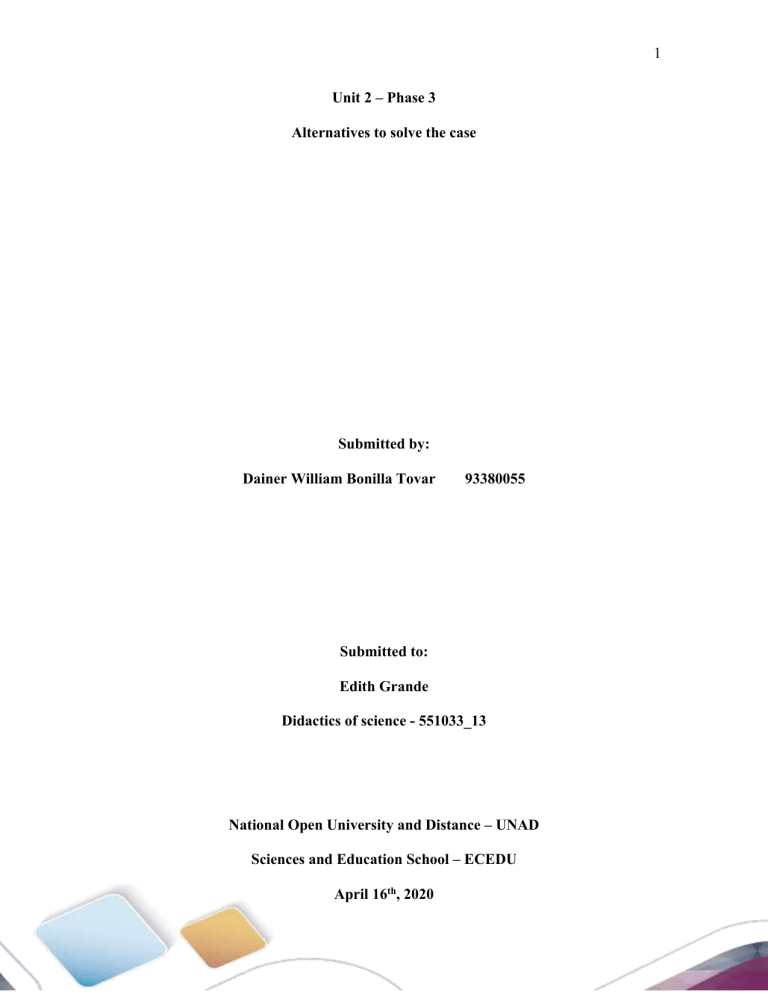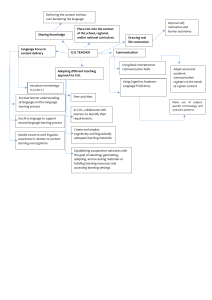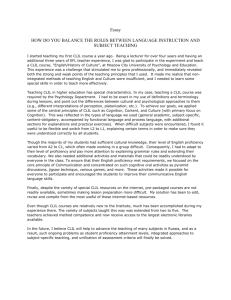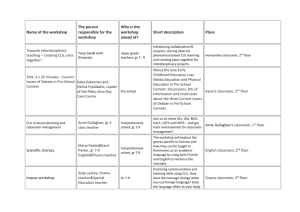
1 Unit 2 – Phase 3 Alternatives to solve the case Submitted by: Dainer William Bonilla Tovar 93380055 Submitted to: Edith Grande Didactics of science - 551033_13 National Open University and Distance – UNAD Sciences and Education School – ECEDU April 16th, 2020 2 ALTERNATIVES TO SOLVE THE CASE Step 1. Reading: A. What is the difference between teaching science through a CLIL approach and a regular class without this approach? In a regular class the emphasis may be focused in the language or in the content whereas in a class with CLIL the emphasis of the class is in content and language at the same time, the order can vary according to the students’ needs. The fact of being exposed to the English language for learning subjects all the time allows students to improve their language skills. This means that students can improve their English language skills through the learning of contents of a subject, and subjects may be learnt through the use of English language. CLIL requires teachers to have a high English level to explain all the topics about the subject to be taught, explain new concepts introduced in the subject, differentiate similar words in pronunciation but with different meanings, for example. Finally, another big difference is that teachers have to face the lack of science materials for their classes. B. What is the role of the foreign language (English) in such a lesson of science? English language is very important for students to acquire and understand all knowledge about the different topics or subjects taught, taking into account the specific terms used in teaching science. Besides, it facilitates the group work which requires to share information, explain procedures and explain the results of those procedures, etc. For teachers, owning a high English level implies the possibility of teaching correctly all about the subjects such as, explaining unknown terms, differentiating words with similar 3 pronunciation but with different meanings and provide students with all necessary information to clarify any doubt about the subject that's being taught. Step 2: Examples: A. 3 examples of the 4 Cs technique: FIELD Geography CONTENT The atmosphere COMMUNICATION COGNITION CULTURE What’s the students think Researching atmosphere? about the effects about how What is the that the people in other composition of the disappearance of countries work atmosphere? the atmosphere to protect the Why is the atmosphere could have on atmosphere. important? people or living beings in general. Biology Chemistry The cell and its functioning The matter Students will be able Students will The students to identify the concept analyze and investigate how of cell, types of cell, identify the main the cells its composition, the differences influence the basic functions of its between human body structures, and the cell eukaryotic and traits according shapes. prokaryotic cells. to the race What’s the matter? Students will Students What are the work in pairs to develop an properties of the create a concept experiment to matter? map to explain make What are the states of the most relevant comparisons the matter? aspects of the among the states What kind of changes matter. of matter does the matter experiment? 4 What kinds of matter are? B. Information about the language in CLIL: what are the types of language that can be studied in a science lesson? Explain them in your words. According to the reading, there are three types of language that can be studied in a science lesson, and they are the following: the subject-specific language of the science subject: This is the essential language in the science subject, which includes the basic terms for its teaching. The general-academic language: This type of language describes the language that is present in many other subjects, which means it’s not exclusive for science subject. The peripheral language of the classroom: It’s the own style of language used by the teachers to establish communication with students in the classroom, and manage the class properly in a foreign language. C. 3 examples of the types of language in CLIL: TYPES OF LANGUAGE The subject-specific language of the science subject DEFINITION EXAMPLE This is the essential language If we are going to speak about in the science subject, which the cell, it’s very important the includes the basic terms for its knowledge of certain terms teaching. included membrane, prokaryotic, eukaryotic, endoplasmic reticulum, peroxisome, etc. The general-academic This type of language describes When the teacher asks the 5 language the language that is present in students to work in groups and many other subjects, which explain the characteristics of an means it’s not exclusive for earthquake. As each member of science subject. the group must make contributions, the structures of language to be used could be: I think that there are many…, the main characteristic is …, one of the most relevant characteristics…, etc. The peripheral language of the It’s the own style of language When the teacher explains the used by the teachers to rules that must be followed in establish communication with the lab: students in the classroom, and Don’t run manage the class properly in a Wear gloves foreign language. Do what I say classroom Don’t eat or drink Don’t leave the lab without permission In this case, the teacher has a kind of script to explain the rules. D. Answer to the questions of the last part: What happens when a teacher has knowledge in English but not in sciences? Or in sciences but not in English? CLIL is very clear when emphasizing the complement that has to take place between content and language. In both cases, nothing will work properly, especially if we take into account the complement that must exist between language and content. In the first case, it’s evident that none teacher can be able to teach something that doesn’t 6 know; the fact of having knowledge in the English language is not enough to stand in front of a group of students and answer their questions about the subject correctly. Taking in mind his lack of knowledge about the science subject, it’s impossible for the teacher to fulfill the objectives proposed for the different topics included in the curriculum and in the lesson plan. In the second case, the lack of knowledge of the English language even though having the knowledge on the science subject represents a serious obstacle for the teacher to explain clearly the different concepts involved in the science subject, so, the teacher would have to resort to the use of the native language for it. In both cases, the teaching-learning process would have no sense and it would end up being a waste of time for both teachers and students. What happens when students possess knowledge in science but lack of English language? It’s known that all students need the motivation to carry out a successful learning process, and at this point, the knowledge of English language plays a key role, since the simple fact of not understanding what it’s being taught could lead to totally different results than expected, that is, students could be unmotivated, confused and frustrated by not being able to obtain the required knowledge on the science subject. How can be used the L1 or the native language of students (Spanish) in the sciences classes? The native language of students (Spanish) can be used in the science class to provide more and detailed information about a specific aspect of a topic. This could 7 encourage the students to participate more actively in the class, and keep them motivated to learn. On the other hand, the teacher could consider the use of the Spanish language as a means to communicate his ideas more easily. How can the teacher choose the topics to teach? Despite the fact that there is a curriculum that concentrates all the subjects to be taught in the different areas of science, the teacher could resort to a previous evaluation of the students' knowledge, and in this way determine the main topics to be taught during the school period, according to the students’ needs. What are the best types of activities and methodologies to apply in the sciences classes? The best and more recommended activities and methodologies to apply in the science classes are those that involve the students’ active participation, such as: Concept and mind maps: This provides the students the opportunity to communicate what they know on a topic using their own words. Context-based learning: This method allows the students to be familiar with new information, analyze it in comparison to what they know about the topic, and make their own conclusions. Projects: This method is excellent for the students to put into practice all what they have learned in theory. Mini-labs: This allows the students to participate actively in the classroom activities tending to illustrate concepts, and make them easier to understand. 8 Documented problem solving: This method provides the students with the possibility of expressing their ideas and opinions while solving a problem step by step. Step 3. Solutions: Taking into account the advanced English level of the teachers, and the fact that some of them are willing to assume the challenge of teaching science, it could be possible to promote training on science for all those teachers who seem to be motivated to help by teaching science. Their work could be supported by the use of tools provided by the ICT to get familiar with the science subjects’ contents. All the GBS teachers should develop joint research work on the activities that best suit the science class, to provide the new teachers with pedagogical tools that facilitate the teaching process. Finally, the use of textbooks and other resources provided by computer tools could help the new teachers to get the required science subject knowledge through the language. 9 REFERENCES Blanco, D. (n.d.). Partes de la célula en inglés. Retrieved from https://es.educaplay.com/recursos-educativos/1023985partes_de_la_celula_en_ingles.html Edsys. (n.d.). 50 innovative teaching methods in science [Message in a blog]. Retrieved from https://www.edsys.in/innovative-science-teaching-methods/ Kelly, K. (2010). CLIL in natural science subjects: language and task. Retrieved from https://core.ac.uk/download/pdf/11503455.pdf Mattheoudakis, M., Alexiou, T., & Laskaridou, Ch. (2011). To CLIL or not to CLIL? The case of the 3rd Experimental primary school in Evosmos. Retrieved from https://www.researchgate.net/publication/277019865_To_CLIL_or_not_to_CLIL_T he_case_of_the_3rd_Experimental_primary_school_in_Evosmos University of Cambridge. (n.d.). teaching science through English - a CLIL approach. Retrieved from http://www.geo-clil.ugent.be/wpcontent/uploads/2016/03/Teaching-Science-through-English-A-CLIL-Approach.pdf


